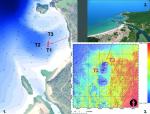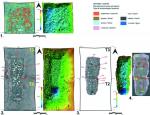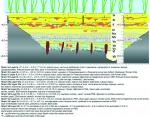Summary (English)
UNDERWATER ARCHAEOLOGICAL EXPLORATIONS AT THE MOUTH OF THE RIVER OF ROPOTAMO (Kalin Dimitrov – kalin.d@abv.bg, Nayden Prahov, Jonathan Adams) The site was located between Cape St. Demetrius (Skombolito) and the mouth of the River of Ropotamo. It was discovered in 1976 and explored during the 1980s. In 2018, the explorations continued in Trenches T2 and T3. Stratum I was the present-day sea bottom at 3.20 m in depth and the ground beneath down to 60 cm in depth. It contained finds of the Ottoman period, the Middle Ages and single sherds of Late Antiquity. Stratum II was 30 – 40 cm thick and contained Roman and Late Antique finds: imported and local amphorae, kitchenware, red-gloss pottery, glass vessels, terracotta lamps, sherds from terra sigillata, carbonized branches and trunks. Stratum III contained single finds of the pre-Roman period: a Late Archaic Ionian kylix discovered in 1988, black-gloss sherds of the Hellenistic period, single sherds of Thracian greyware. Strata I, II and III were accumulated in a bay that was used as a harbor and constituted a port accumulation. Stratum IV was a hiatus. Stratum V contained finds of the Early Bronze Age: sherds, intact ceramic vessels, wooden posts and fragmentary burned wattle-and-daub. In 2017 and 2018, 12 vertical wooden posts were discovered stuck into the ground, 15 – 25 cm in diameter. The lower end of the posts is pointed, showing traces of chopping with axes. The calibrated C14 dates from nine samples of wooden posts dated to the beginning of the first phase of the Early Bronze Age in 3080 – 2970 cal. BC. The settlement was situated along the right bank of a small stream, a right tributary of the River of Ropotamo. The settlement seemed to have been abandoned by its inhabitants.
- Kalin Dimitrov - Centre for Underwater Archaeology
- Nayden Prahov - Archaeological Institute with Museum
- Jonathan Adams - Centre for Maritime Archaeology - University of Southampton
Director
- Jonathan Adams - Centre for Maritime Archaeology - University of Southampton
- Kalin Dimitrov - Centre for Underwater Archaeology
- Nayden Prahov - Archaeological Institute with Museum
Team
Research Body
- Archaeological Institute with Museum
- Centre for Maritime Archaeology - University of Southampton
- Centre for Underwater Archaeology






![Download [PDF]](/excavation/skins/fasti/images/results/download_sml.png)

